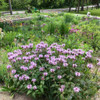This superb low-growing beebalm has light lavender-pink flowers, mint-scented leaves, and a more compact and smaller habitus than other Monardas.
The flowers are purple-tinged or spotted, and the leaves are dark or brown-red at the tips. This perennial is very tolerant of droughts as well as some shade. It doesn’t suffer with powdery mildew even in hot and humid climates.
Magnet for hummingbirds, butterflies, bumblebees and native bees. A great choice for a sunny flower border, butterfly garden, hummingbird garden, low maintenance garden, deer resistant landscaping, for naturalizing in drier woodland edges, close to rocks etc.
Good perennial company could be these native wildflowers and their cultivars: Amorpha canescens, Asclepias tuberosa, Asclepias verticillata, Aster oblongifolius, Aster laevis, Aster ericoides, Coreopsis, Cunila origanoides, Echinacea purpurea hybrids, Echinacea tennesseensis, Echinacea pallida or angustifolia, Echinacea paradoxa, Euphorbia corollata, Penstemon, Pycnanthemum, Rudbeckia missouriensis, Salvia lyrata, Solidago nemoralis, Sisyrinchium angustifolium and grasses like Boutelloua gracilis, Eragrostis elliotii, Koeleria macrantha or cristata, Muhlenbergia capillaris, Sporobolus heterolepis, and Schizachyrium scoparium.
From non-native perennials, choose Allium 'Millenium', Nepeta, Calamintha nepeta, Iris x germanica, Iris tectorum, Lavandula officinalis, Lavandula x intermedia, Perovskia, Stachys byzantina, Stachys macranthaand and other drought tolerant perennials.
Picture copyright : peganum, Wikipedia Commons
Blooming Time: June to July, flowers for 3-4 weeks
Size: 1.5-2’ tall and wide
USDA Zones: 5 to 8
Culture: full sun, half shade, grows well in average soil with, soils with some drainage, rocky, shallow, drier soils. Very drought tolerant.
Moisture Needs: dry, medium-dry, medium
Origin: Native to central and southern United States from Indiana to Alabama and west to Kansas, Arkansas and Texas (with the densest populations in Illinois, Missouri and Arkansas). Naturally grows in drier savannas, rocky upland forests, limestone or sandstone glades, bluffs, drier woodland clearings, roadsides etc.
Deer/Rabbit Resistant: yes / yes
Attracts Butterflies or Pollinators: offers nectar to long-tongued bees, bumblebees, butterflies, skippers, hummingbird moths, and bee flies. Caterpillars of several moths feed on the foliage (also on other species of Monarda), as well as beetles.
Attracts Hummingbirds: yes
Pot Size: 3.5" x 4" perennial pot (1.22 pt/580 ml)







